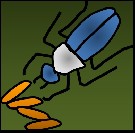Integrated disease management
Integrated rice disease management is the combination of different methods to control diseases in a cost-effective way, based on sound environmental management. Pathogen populations are kept at low levels, not causing economic damage, using a combination of appropriate technologies. None of these methods or techniques can by itself ensure efficient and sustainable protection.
Primary elements of integrated management
Integrated disease management focuses on varietal resistance, because it is the simplest and cheapest way to limit pathogen populations, and thus the most accessible method for farmers.
This means that varieties are chosen because they are resistant to disease infestation. The method gives good results, especially in the case of rice yellow mottle virus and blight.
However, varietal resistance is often not enough to protect the crop in a sustainable way. For instance, for blast, the occurrence of new pathogen races or environmental conditions favorable to the disease (high level of inoculum, overcast sky, high atmospheric humidity) can trigger epidemics on previously tolerant varieties. For this reason, AfricaRice recommends an integrated control strategy in which varietal resistance is accompanied by preventive measures both favorable to rice and reducing disease proliferation. These measures are detailed below.
Crop management techniques
-
Appropriate sowing or transplanting date to avoid flowering coinciding with high atmospheric humidity (generally during the rainy season). High humidity is favorable to blast infestation.
-
Synchronized sowing and transplanting to avoid build up of insect pests that can transmit diseases such as RYMV.
-
Using healthy or treated seed—fungal diseases (blast) and bacterial diseases can be transmitted by seed.
-
Destruction of weeds and crop residues that can act as reservoirs for pathogens and insect vectors.
-
Balanced and reasonable fertilizer use: high doses of N can increase blast infestations, while high doses of K generally limit blast infestation.
-
Destruction of rice stubbles and vector host plants to avoid pathogen build up and to interrupt the life-cycles of insect vectors.
-
Cleaning of canals and borders of plots that can be reservoirs of RYMV, alternative hosts and insect vectors.
Chemical control—secondary elements of integrated management
Chemical control consists of using preventive or curative products to treat the crop. Chemical control is only justified when no other method is available. In the case of rice, this form of control is hardly ever used. However, sometimes it is recommended that seed be treated to prevent diffusion of pathogenic fungi associated with seed transportation.
Extract from PLAR-IRM Curriculum: Technical Manual (Wopereis et al., 2009)













